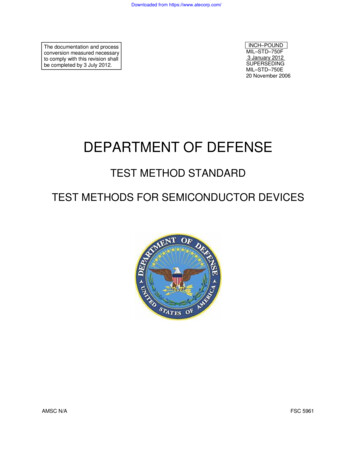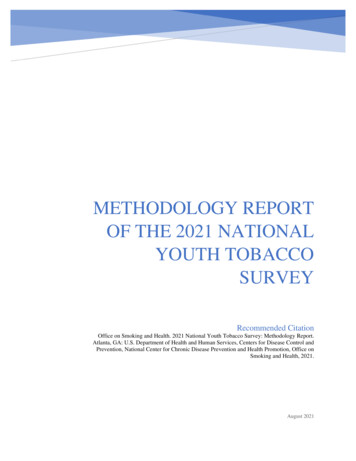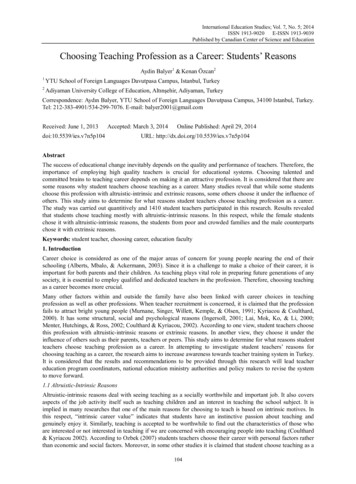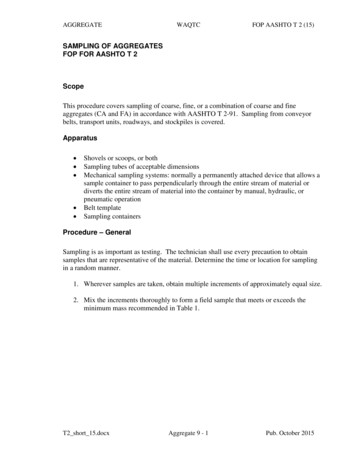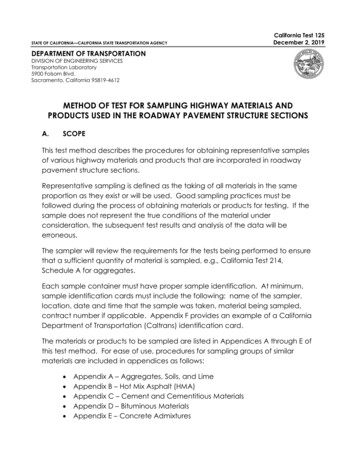
Transcription
STATE OF CALIFORNIA—CALIFORNIA STATE TRANSPORTATION AGENCYCalifornia Test 125December 2, 2019DEPARTMENT OF TRANSPORTATIONDIVISION OF ENGINEERING SERVICESTransportation Laboratory5900 Folsom Blvd.Sacramento, California 95819-4612METHOD OF TEST FOR SAMPLING HIGHWAY MATERIALS ANDPRODUCTS USED IN THE ROADWAY PAVEMENT STRUCTURE SECTIONSA.SCOPEThis test method describes the procedures for obtaining representative samplesof various highway materials and products that are incorporated in roadwaypavement structure sections.Representative sampling is defined as the taking of all materials in the sameproportion as they exist or will be used. Good sampling practices must befollowed during the process of obtaining materials or products for testing. If thesample does not represent the true conditions of the material underconsideration, the subsequent test results and analysis of the data will beerroneous.The sampler will review the requirements for the tests being performed to ensurethat a sufficient quantity of material is sampled, e.g., California Test 214,Schedule A for aggregates.Each sample container must have proper sample identification. At minimum,sample identification cards must include the following: name of the sampler,location, date and time that the sample was taken, material being sampled,contract number if applicable. Appendix F provides an example of a CaliforniaDepartment of Transportation (Caltrans) identification card.The materials or products to be sampled are listed in Appendices A through E ofthis test method. For ease of use, procedures for sampling groups of similarmaterials are included in appendices as follows: Appendix A – Aggregates, Soils, and LimeAppendix B – Hot Mix Asphalt (HMA)Appendix C – Cement and Cementitious MaterialsAppendix D – Bituminous MaterialsAppendix E – Concrete Admixtures
California Test 125December 2, 2019This test method addresses acceptable locations that are routinely used forsampling. If it is necessary to sample from other locations, check the referencesor contact the Transportation Laboratory.B.REFERENCESAASHTO R 47Reducing Samples of Asphalt Mixtures toTesting SizeAASHTO R 66Sampling Asphalt MaterialsAASHTO R 76Reducing Samples of Aggregate to Testing SizeAASHTO R 90Sampling Aggregate ProductsAASHTO T 209Theoretical Maximum Specific Gravity (Gmm) and Density ofAsphalt MixturesAASHTO T 275Bulk Specific Gravity (Gmb) of Compacted Asphalt Mixturesusing Paraffin-Coated SpecimensAASHTO T 283Resistance of Compacted Asphalt Mixtures to MoistureInduced DamageAASHTO T 308Determining the Asphalt Binder Content of Asphalt Mixturesby the Ignition MethodAASHTO T 312Preparing and Determining the Density of Asphalt MixtureSpecimens by Means of the Superpave Gyratory CompactorASTM C183Sampling and the Amount of Testing of Hydraulic CementASTM C260Air-Entraining Admixtures for ConcreteASTM C494Chemical Admixtures for ConcreteASTM C702Reducing Samples of Aggregate to Testing SizeASTM D140Sampling Asphalt MaterialsASTM D75Sampling AggregatesASTM D3665Random Sampling of Construction MaterialsASTM E300Sampling Industrial ChemicalsCalifornia Test 306 Reducing Samples of Asphalt Mixtures to Testing SizeAmerican Public Health AssociationAmerican Water Works AssociationWater Environment Federation – “Standard Method for the Examination ofWater and waste Water.” Collection and Preservation of SamplesC.APPARATUS1. Sample Splitters: sample splitters (riffle splitters) must have an even numberof equal-width permanently fixed chutes which discharge alternately toeach side of the splitter. There must be no less than a total of 8 chutes for-2-
California Test 125December 2, 2019splitters used for coarse aggregate and 12 chutes for fine aggregate. Theminimum width of the individual chutes shall be approximately 50% largerthan the largest particles in the sample to be split. For dry, fine aggregatein which the entire sample will pass the 3/8 in sieve, the minimum width ofthe individual chutes should be at least 50% larger than the largestparticles in the sample to be split with a maximum width of 3/4 in.The splitter must be equipped with 2 receptacles to hold the 2 halves ofthe sample following splitting. It must also be equipped with a hopper orstraight-edged pan by which the sample may be fed at a controlled rateto the chutes. The hopper or straight-edged pan must have a widthequal to or slightly less than the overall width of the assembly of chutes.The splitter and accessory equipment must be so designed that thesample will flow smoothly without restriction or loss of material.Note: Typically, 3 different sized splitters (large, medium, and small) aresufficient.2. Quartering Canvas: a sheet of canvas approximately 5 ft 5 ft used toquarter aggregates in the field.3. Sample Containers: various sized heat resistant containers are required.Some should have the following approximate capacities: 65 lb, 15 lb,7.5 lb, 1 lb, and 0.5 lb.4. Fan, Forced Air Heater, or Oven: to remove moisture from wet samples.When air drying is not practical, typical equipment may be fans with orwithout heating coils or a vented, forced draft oven capable ofmaintaining a temperature of 140 9 F (60 5 C) or 230 9 F (110 5 C).5. Automatic Sampling Device: a device capable of taking homogenoussamples. The device may be electric, hydraulic, pneumatic, or anycombination of the three. The device must be capable of capturing anddischarging material into a container without overflowing.-3-
California Test 125December 2, 2019D.DRYING OF SAMPLES1. Dry wet samples sufficiently to permit a complete separation on the No. 4sieve and to develop a free-flowing condition in the portion passing theNo. 4 sieve. Drying may be performed by any means that does not heatthe aggregate in excess of 140 F (60 C) or cause degradation of theparticles. Sunlight, oven, or forced drafts of warm air are the mostcommon drying methods:a. Drying can be expedited by occasionally stirring the material duringthe drying process.b. Drying may be done at 230 9 F (110 5 C) when all subsequenttests require or permit drying at this temperature or above.2. When drying aggregate samples containing reclaimed asphalt pavement(RAP),the oven drying temperature must not exceed 100 F. After drying,articles of RAP can be separated by hand so that the particles of the fineaggregate portion are no larger than ¼ in. Care must be taken to avoidfracturing the aggregate.E.COMBINING OR REDUCING SAMPLESSome sampling procedures result in excess material. It is practical to reduce theamount to a sample size equal to or slightly in excess of the minimum weightrequired before transporting or shipping to the laboratory. The use of a rifflesplitter is preferred. However, splitting with a quartering canvas is acceptable ifcarefully performed. Splitting with a quartering canvas of any HMA is notacceptable.If combining samples will result in a sample weighing in excess of 100 lb, spliteach sample separately and combine the smaller portions.Splitter, accessory equipment, and tools may be heated to 230 F (110 C).1. Splitting samples with a riffle splitterThe procedures for splitting and reducing samples with riffle splitters are asfollows:a. The sample must be at a free-flowing condition.-4-
California Test 125December 2, 2019b. Thoroughly mix the sample and spread it evenly across the pan orhopper.c. Open the hopper gate or pour the material from the pan so thatthe material flows evenly through all the chutes. Control the rate ofdischarge as necessary to maintain a continuous flow of materialsthrough the chutes.d. Continue to split or combine successive portions until the desiredsample size is achieved.e. Clean excess material from riffle splitters after each use.2. Splitting aggregate samples with a quartering canvasA quartering canvas can be used for splitting a sample weighing up to100 lb. The procedures for splitting samples with a quartering canvas areas follows:For samples weighing between 20 and 100 lb:a. Place the sample in a conical pile in the center of the canvas. Mixthe sample by shoveling material from around the bottom edges tothe center of the pile. Place each shovelful so that the materialspills over the cone equally in all directions.b. Flatten the cone with the shovel, spreading the material to acircular layer of uniform thickness.c. Insert a stick (or pipe or shovel handle) under the canvas at thecenter of the pile and lift both ends, dividing the sample into 2equal parts. Remove the stick leaving the canvas in a foldedposition. Insert the stick (or pipe or shovel handle) under the canvasat the center of pile at right angles to the first division and again liftboth ends, dividing the sample into 4 equal parts. In lieu of dividingby use of a stick, a square point shovel may be used to divide thesample into 4 equal parts.-5-
California Test 125December 2, 2019d. Take samples from 2 diagonally opposite quarters being careful toclean all the fines from the canvas.e. Repeat steps a through d, combining split portions as necessaryuntil the desired sample size is achieved.For samples weighing less than 20 lbs:a. Place the sample on the canvas or a clean sheet of paper. Mixthoroughly with a trowel and form into a conical pile.b. Flatten the pile by pressing downward with the trowel.c. Separate into quarters with trowel at right angles.d. Take samples from 2 diagonally opposite quarters being careful toclean all the fines from the canvas or paper.e. Repeat steps a through d combining split portions as necessary untilthe desired sample size is achieved.F.REPORTING OF RESULTSWhen required, submit sample identification information electronically inaccordance with the DIMEXML format and guidance documents found at thefollowing link: https://dime.dot.ca.gov/index.php?r help/submittestresult G.HEALTH AND SAFETYIt is the responsibility of the user of this test method to establish appropriatesafety and health practices and determine the applicability of regulatorylimitations prior to use. Prior to handling, testing, or disposing of any materials,testers must be knowledgeable about safe laboratory practices, hazards andexposure, chemical procurement and storage, and personal protective appareland equipment.Refer to the Safety Manual for your Laboratory.End of Text(California Test 125 contains 31 pages)-6-
California Test 125December 2, 2019Appendix AAGGREGATES, SOILS, AND LIMEA.SCOPEAppendix A contains the procedures for sampling coarse and fine aggregatesat various locations for HMA, portland cement concrete, aggregate base andsubbase, treated bases, bituminous seals, polymer concrete, soil, and lime.B.PROCEDURESObtain sufficient materials to equal or exceed the minimum sample weightrequired. If taking material from multiple locations for a composite sample,obtain approximately equal amounts of material from each location andcombine to form a field sample which is equal to or in excess of the minimumweight required. Quarter or split the sample to the required size.AggregatesA. From HMA Batch Plants1. At each aggregate storage bin, the contractor is required to provide asafe and suitable sampling device that will provide a sample of theaggregate as it is being discharged into the weigh hopper. This devicenormally consists of a pan of sufficient size to intercept the entire crosssection of the discharge stream and hold the required quantity ofmaterial without overflowing. A set of rails is necessary to support the panas it is passed under the discharge stream.2. Supplemental fine aggregate may be sampled from the feed line or surgetank preceding the proportioning device. The selected location must notbe pressurized.3. Baghouse dust may be sampled from the bottom of the baghouse, underthe feed screw with a sampler that is fixed under the baghouse. Thesampler consists of a valve, a section of pipe, and a cap for the bottomend of the pipe. To sample, close the valve, remove the pipe cap, andclean the pipe. Then, replace the cap and reopen the valve. When thepipe is full, close the valve, remove the cap, and collect the sample ofdust.-7-
California Test 125December 2, 2019Baghouse dust may also be sampled similarly to supplemental fineaggregate.B. From HMA Continuous Mixing Plants1. The contractor is required to provide a safe and suitable aggregatesampling device for obtaining a sufficient sample of the combinedaggregate while the plant is in full operation. The device must be locatedin advance of the point where the aggregate enters the dryer-drummixer.Some plants are equipped with a sampling device (pan) similar to onesused for batch plant bins. This device normally consists of a pan ofsufficient size to intercept the entire cross-section of the discharge streamand hold the required quantity of material without overflowing. A set ofrails is necessary to support the pan as it is passed under the dischargestream.Devices used to divert the stream of combined aggregate into acontainer must be used with care. Samples taken using diverters thatmove vertically to cut the stream are not permitted.Side-to-side diverters are less susceptible to segregation problems as theaggregate stream will normally be layered horizontally. A representativesample may be obtained by diverting the whole stream into an 8 to 12 in.diameter pipe and wasting the first and last quarter of the sample. Thismethod often requires splitting the remaining portion of the sample.Systems that divert the stream of aggregate to a belt for sampling allowthe sample size to be selected. Use 2 templates that conform to theshape of the belt to separate an appropriate size section from the middlehalf of the diverted aggregate. Sample all the material between thetemplates.2. Supplemental fine aggregate may be sampled from the feed line or surgetank preceding the proportioning device. The selected location must notbe pressurized.3. Baghouse dust may be sampled from the bottom of the baghouse, underthe feed screw, with a sampler that is fixed under the baghouse. Thesampler consists of a valve, a section of pipe, and a cap for the bottom-8-
California Test 125December 2, 2019end of the pipe. To sample, close the valve, remove the pipe cap, andclean the pipe. Then, replace the cap and reopen the valve. When thepipe is full, close the valve, remove the cap, and collect the sample ofdust.Baghouse dust may also be sampled similarly to supplemental fineaggregate.C. From Portland Cement Concrete Batch PlantsThe contractor is required to provide safe and suitable facilities, includingnecessary splitting devices, for obtaining samples of aggregates.Sampling the belt feeding; the continuous mixer or the batch plant binsimmediately preceding the weigh hopper is the most prevalent location forpulling aggregate samples. Use 2 templates that conform to the shape of thebelt to separate an appropriate size section. Sample all the material betweenthe templates. Completely remove the aggregate from a section of thestopped conveyor belt. Quarter or split the sample to the required size.Many plants are equipped with large storage bins (i.e., 100 to 150 cu yd). Onsmall projects, samples from the belt that feeds the bins may not berepresentative of the aggregate used on the project if the bins have material inthem. In this case, empty the bins prior to sampling. To eliminate this problem, arequest that the plant operator keep the bins empty or near empty prior tosampling is recommended.D. From WindrowsObtain samples from within the middle half of the windrow. Sample the entirecross section of the windrow before water is added. This can be done usingsteel plates or plywood to isolate the initial sample.An alternate procedure is to remove a cross section of the windrow at least thewidth of 1 shovel. From either remaining face, select an appropriate width toprovide the needed sample and make a vertical cut. Be sure to include thematerial that sloughed after removing the cross section.E. From RoadwaysObtain at least 3 approximately equal portions selected at random locationstransversely across the width of the roadway after the material has been spread-9-
California Test 125December 2, 2019and prior to compaction. Take all portions from the roadway for the full depthof the material, taking care to exclude any underlying material. Combine the 3portions to form a field sample that is equal to or in excess of the minimumweight required.F. From Transportation UnitsObtain samples from a hauling vehicle from at least 3 points a minimum of 12inches below the surface and evenly distributed over each individual vehicle.Establish the sample location at a distance from the edge that is approximatelyone-third of the bed.G. From StockpilesIn some cases, it may be necessary to sample from stockpiles for testing. In suchcases, the procedure should ensure that segregation does not introduce aserious bias in the results.At times, “one sized” materials such as No. 4 screenings are stockpiled at the jobsite. This type of material may be sampled for acceptance testing from thestockpile.It is very difficult to ensure unbiased samples when sampling from stockpiles. Thisis due to segregation that occurs when material is stockpiled and coarserparticles roll to the outside base of the pile. For all aggregates, use a loader todevelop a separate, small sampling pile composed of materials drawn fromvarious levels and locations in the main pile. Drag off the top half of the newpile. Take a shovel full of material from several locations of the remaining half ofthe pile.Where power equipment is not available, samples from stockpiles should bemade up of at least 3 portions, 1 each from the top third, at the midpoint, andthe bottom third of the volume of the pile. A board shoved into the pile justabove the sampling point can prevent further segregation.When sampling stockpiles of fine aggregate, remove the outer layer that mayhave become segregated and take the sample from the material beneath. Ifavailable, sampling tubes (with a diameter of approximately 1 in. and aminimum length of 5 ft) may be inserted into the pile at random locations toextract a minimum of 5 portions of material to form the sample.- 10 -
California Test 125December 2, 2019Samples can be taken from the stream of material at the end of the moving beltthat discharges onto the stockpile. These belt systems can be lowered andmoved back and forth to assist sampling. Care must be exercised to interceptthe entire discharge stream without overflowing the sampling device.SoilA. From the SourceSample by means of test holes (augured, dug with post-hole digger or shovel, orby other mechanical means). Ensure the method of sampling does not changethe physical characteristics of the material. Sample the test holes to therequired depth. Take separate samples to represent different material types sothat all material types are represented. Reference the location of each sampleon the sample identification card.B. From the Job SiteSample from within the middle half of the deposit. Take a composite samplefrom at least 3 locations in a line transversely across the section.LimeIf lime slurry is being sampled, obtain a minimum of two 1 qt cans with friction lidsor poly containers with screw-on lids. Use care to ensure uniform distribution ofthe solids before sampling.If quicklime or hydrated lime is being sampled, obtain a minimum of 2 lb in acan with a friction lid or a poly container with a screw-on lid.A. At the Production PlantTake samples from the conveyor system with the conveyor stopped. Scoopsamples (grab samples) from the sample port opening.When sampling granular lime for grading analysis, take the entire cross-sectionof the conveyor.B. At the Job SiteTake samples from the distributor truck during application.C. From Pneumatic Tanker- 11 -
California Test 125December 2, 2019Normally, a thief sampler is used to obtain the sample through the inspectioncover or loading hatch. The thief is pushed 2 0.5 ft into the material,withdrawn, and emptied into the can or container.- 12 -
California Test 125December 2, 2019APPENDIX BHOT MIX ASPHALT (HMA)SCOPEAppendix B contains the procedures for sampling plant-produced hot mixasphalt (HMA). HMA includes non-rubberized asphalt mixtures (Type A HMA,Open Graded Friction Course (OGFC), and Bonded Wearing Course (BWC))and rubberized asphalt mixtures (Rubberized HMA – Gap Graded (RHMA-G),Rubberized HMA – Open Graded (RHMA-O), and BWC). Procedures areprovided for sampling at the plant, from transport vehicles, or on the project site.For reducing samples to testing size, refer to California Test 306.SAMPLE REQUIREMENTSThe minimum sample weight required for routine testing will depend upon thetype of testing and the tests to be performed. Table 1 summarizes minimumrequired sample containers for routine testing. The quantity of samplecontainers must be evaluated based on actual project requirements.The sample location must be selected at random, and not systematically or bythe judgement of the inspector. Determine a random sample location usingprocedures such as those outlined in American Society for Testing Materials(ASTM) D 3665 or similar. From this location, fill the necessary amount ofcollection or sample containers to obtain the approximate sample weight.- 13 -
California Test 125December 2, 2019TABLE 1Minimum Required Sample Containers for Routine TestingSource of Material / Testing tobe PerformedaType of TestingNumber of ApproximateSampleTotal WeightContainers(lbs) aProduction, individual sublots(AASHTO T 209 and T 308)QC or Acceptance460Production, individual sublots(AASHTO T 209 and T 308)QC, Acceptance,and Dispute12180Production, individual sublots(AASHTO T 209, T 308, T 312,and T 275)QC or Acceptance8120Production, individual sublots(AASHTO T 209, T 308, T 312,and T 275)QC, Acceptance,and Dispute24360JMF Verification or ProductionStartup (AASHTO T 209, T 308, T312, T 275, T 283, and T 324)QC or Acceptance16240JMF Verification or ProductionStartup (AASHTO T 209, T 308, T312, T 275, T 283, and T 324)QC, Acceptance,and Dispute48720Based on approximately 15 lb per sample containerEQUIPMENTSquare-point shovel(s), release agent, and sample containers are required. Fornon-rubberized asphalt mixtures, collection containers, a metal spatula, and amechanical quartering device with a minimum of 4 receptacles, are required.Refer to AASHTO R 47, Section 7.1.Sample containers must be cardboard boxes 8 in. x 8 in. x 4 in. or 8½ in. x 8½ in. x4½ in. For RHMA-O, BWC, or OGFC, use parchment paper or other release linerto line boxes.Collection containers used for sampling non-rubberized asphalt mixtures andreceptacles used with a mechanical quartering device must be appropriatelysized galvanized steel pails or similar heat-resistant metal containers.- 14 -
California Test 125December 2, 2019The sample identification must classify containers of material from multiplelocations or sections as 1 sample regardless of the number of containers.PROCEDURESGeneralAnti-stick or release agents that do not contain solvents may be used on tools ifthe tool is cleared of residual material before sampling. Tools may bepreheated to prevent accumulation of material.Place the collection or sample containers as near as practical to the samplinglocation to minimize handling time.Using a clean, square point shovel, fill shovel with one single push. Do not overfillthe shovel and lift it slowly to avoid the material from rolling off. Deposit HMAmaterial into appropriate containers. Do not overfill the sample containers.Preparing Sampling LocationsA. Silo or Batch Plant Discharge (non-rubberized asphalt mixtures only)1. With a trailer-mounted bulk sampler system, take a single drop or multipledrops from the silo or batch plant discharge into a material hopper thatwill hold the material.2. Discharge the material directly into a mechanical quartering device toreduce material to sample size.B. Plant – Deposited Pile1. Place a single drop or multiple drops from a loader bucket or end dumptruck for a total of 2 to 4 tons of material on a level pad (e.g., compactedsoil, concrete, or asphalt).2. Back-drag the deposited pile with a loader to form a pile approximately16 in. high.3. Divide the pile into 4 approximately equal quadrants using paint or ashovel. See Figure B.1.- 15 -
California Test 125December 2, 2019FIGURE B.1 Plant – Back-dragged Deposited PileC. Plant - Conveyor System – Automatic Sampler OnlyWhen sampling at HMA plants with an automatic sampling device betweenthe drum discharge and storage silos, sample 4 individual times (4 “pulls”)equivalent to full belt cuts or full stream diversions. Fill containers fromseparate pulls 1 to 4 minutes apart.D. Plant - Windrow1. From a bottom dump, produce a windrow of 1 to 2 ft in height, 2 to 5 ft inwidth, and a minimum of 14 ft in length. The edge of the sample areashould be at least 3 ft from either end of the windrow.2. Divide the sample area into 4 sections of approximately equal length.See Figure B.2.3. At each sample location, remove and discard approximately 0.5 ft fromthe top of the windrow.4. Trim and discard the front of each sample location creating a 60 to 90degree angle to the vertical face.- 16 -
California Test 125December 2, 2019FIGURE B.2 Division of Windrow at the PlantE. Transportation Units – Automatic Sampler Only1. For trucks with a single bed configuration, divide the truck bed into 4sections of approximately equal length. See Figure B.3.FIGURE B.3 Single Bed Configuration2. For trucks with a tandem bed configuration, divide each tandem bed into2 approximately equal sections to create a total of 4 sections ofapproximately equal length. See Figure B.4.FIGURE B.4 Tandem Bed ConfigurationF. Jobsite - Mat Behind the PaverSelect 4 sections of approximately equal width immediately behind thepaver starting at a minimum of 1 ft from edge and spaced equally in a linetransversely across the mat. See Figure B.5.- 17 -
California Test 125December 2, 2019FIGURE B.5 Mat Behind the PaverG. Jobsite - Windrow1. Select a sample area of the windrow at a minimum of 8 ft in length. Theedge of the sample area should be at least 3 ft from either end of thewindrow.2. Divide the sample area into 4 sections of approximately equal length.3. Follow procedure for Plant – Windrow, section D, steps 3 and 4.Sampling, Combining, and ReducingA. Non-rubberized Asphalt MixturesFor non-rubberized asphalt mixtures, a sample container includes a portion ofthe sample and one sample container should be representative of the entiresample.1. Label 4 appropriately-sized collection containers A, B, C, and D.a. For a trailer-mounted bulk sampler, fill collection containers directlyfrom an attached mechanical quartering device.b. For a deposited pile at the plant, windrow at the plant, mat behindthe paver, or windrow at the job site, shovel material from eachquadrant or section directly into its corresponding collectioncontainer. Collection containers must be approximately half full.i.Plant – Deposited Pile: Do not sample material within 1 ft of thepile edge or within 1 in. of the base material.- 18 -
California Test 125December 2, 2019ii.Plant and Jobsite - Windrow: Obtain sample(s) from the middleof each of the 4 sections by digging into the vertical faceacross the entire cross-section of the windrow with a shovel ina horizontal motion. Do not take material within 1 ft of thewindrow linear edge, or within 1 in. of the base material.iii.Jobsite - Mat Behind the Paver: Include the full depth of thematerial. Exclude any underlying material (e.g., aggregatebase or tack coat).c. For a conveyor system with an automatic sampler at the plant, fillcollection containers directly from separate pulls 1 to 4 minutesapart. Collection containers must be approximately half full.d. For transportation units, fill collection containers directly from theautomatic sampler. Collection containers must be approximatelyhalf full.i.For each section, use an automatic sampling device to takesamples at least 1 ft from the edge of the bed or sectionborderlines.ii.Take the sample at least 1 ft below the surface of the material.2. Use a mechanical quartering device to combine collection containersinto a composite sample:a. Prior to use, assure the mechanical quartering device is cleared ofresidual material to prevent cross contamination.b. Level the mechanical quartering device to ensure an even flow ofmaterial.c. Make sure the hopper door is closed and latched before placingthe material into the mechanical quartering device.- 19 -
California Test 125December 2, 2019d. Pour all 4 collection containers evenly into the mechanicalquartering device using a continuous pour from multiple directionsaround the hopper to avoid segregation.e. Prior to releasing the hopper, level the material with a metal spatulaor another appropriate, heat-resistant tool.f. Place 4 receptacles under the mechanical quartering device andrelease the hopper door.g. To ensure a composite sample, repeat steps c through f with thecontents of all 4 receptacles.3. Reduce to sample container size:a. Make sure the hopper door is closed and latched before placingthe material into the mechanical quartering device.b. Remove 2 diagonally opposite receptacles from the compositesample produced in step A.2.g and load them into the mechanicalquartering device using a continuous pour from multiple directionsaround the hopper to avoid segregation. Set aside the remaining 2receptacles of material.c. Prior to releasing the hopper, level the material with a metal spatulaor another appropriate, heat-resistant tool.d. Place 4 receptacles under the mechanical quartering device andrelease the hopper. This will yield 4 receptacles each containinghalf the amount of material from the 2 diagonally oppositereceptacles in step b.e. Repeat steps a through d to produce 4 receptacles that yieldenough material to fill 4
AASHTO R 66 Sampling Asphalt Materials . AASHTO R 76 Reducing Samples of Aggregate to Testing Size . AASHTO R 90 Sampling Aggregate Products . AASHTO T 209 Theoretical Maximum Specific Gravity (Gmm) and Density of Asphalt Mixtures . AASHTO T 275 Bulk Specific Gravity (Gmb) of Compacted Asphalt Mixtures using Paraffin-Coated Specimens

